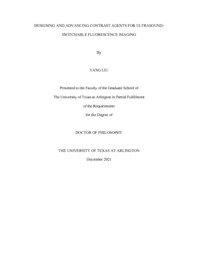
ATTENTION: The works hosted here are being migrated to a new repository that will consolidate resources, improve discoverability, and better show UTA's research impact on the global community. We will update authors as the migration progresses. Please see MavMatrix for more information.
Show simple item record
| dc.contributor.advisor | Yuan, Baohong | |
| dc.creator | Liu, Yang | |
| dc.date.accessioned | 2023-06-28T15:49:08Z | |
| dc.date.available | 2023-06-28T15:49:08Z | |
| dc.date.created | 2021-12 | |
| dc.date.issued | 2021-12-09 | |
| dc.date.submitted | December 2021 | |
| dc.identifier.uri | http://hdl.handle.net/10106/31397 | |
| dc.description.abstract | Fluorescence imaging is a remarkable tool for molecular targeting and multicolor imaging, but it suffers from poor resolution in centimeters-deep tissues. The recently developed ultrasound-switchable fluorescence (USF) imaging has overcome this challenge and achieved in vivo imaging with the help of the indocyanine green (ICG)-encapsulated poly(N-isopropylacrylamide) (ICG-PNIPAM) contrast agent. As USF imaging advances, there is a great demand to expand the contrast agent bank so that applications can be achieved using different types of contrast agents. Also, there is a need to improve the current ICG-PNIPAM nanogel.
This study focused on improving the ICG-PNIPAM nanogel, formulating a novel contrast agent, and exploring dual-modality imaging. First, we controlled the size of the ICG-PNIPAM nanogel by adjusting the quantity of sodium dodecyl sulfate (SDS), and we successfully synthesized an ICG-PNIPAM nanogel from 55.6 nm to 515.1 nm. The ICG-PNIPAM nanogel in different sizes showed great stability and switching repeatability. Further in vivo USF imaging demonstrated that different-sized nanogel accumulated in organs such as the spleen and liver. We achieved both ex vivo and in vivo computed tomography (CT) and USF dual-modality imaging with the gold nanoparticles and ICG-loaded PNIPAM nanogel.
A novel ICG-loaded liposomal microparticle was first formulated for USF imaging. Compared with ICG-PNIPAM nanogel, ICG-liposome had a narrow fully switched-ON temperature range, a near-infrared (NIR) emission peak at 836 nm, and great biocompatibility. Both ex vivo and in vivo USF imaging were successfully conducted and proved that ICG-liposome was another excellent USF contrast agent. Further, the bi-layer lipid membrane was constructed with additional lipid that had pegylated chains and folate targeting groups associated. The size of the liposome was reduced and controlled from 82.3 nm to 162.4 nm. A high increase in fluorescence intensity and a switch-ON temperature closer to body temperature were observed. In addition, the ICG-liposome nanoparticles had a high encapsulation efficiency of more than 80 % and a release efficiency of up to 48.01 % when assisted with ultrasound. A potential USF imaging-guided and ultrasound-assisted drug delivery application can be achieved.
In conclusion, this study not only improved the existing ICG-PNIPAM nanogel with size control but also formulated novel liposomal microparticles and nanoparticles for both ex vivo and in vivo USF imaging. In addition, we achieved CT and USF dual-modality imaging with gold nanoparticle (AuNP) and ICG-loaded PNIPAM nanogel. We strongly believe that with the improvements and innovations accomplished in this study, USF imaging will become a valuable tool in the field of biomedical imaging. | |
| dc.format.mimetype | application/pdf | |
| dc.language.iso | en_US | |
| dc.subject | Liposome | |
| dc.subject | Polymeric nanoparticle | |
| dc.subject | Ultrasound-switchable fluorescence imaging | |
| dc.subject | Dual-modality imaging | |
| dc.subject | Contrast agent | |
| dc.title | Designing and advancing contrast agents for ultrasound-switchable fluorescence imaging | |
| dc.type | Thesis | |
| dc.date.updated | 2023-06-28T15:49:08Z | |
| thesis.degree.department | Bioengineering | |
| thesis.degree.grantor | The University of Texas at Arlington | |
| thesis.degree.level | Doctoral | |
| thesis.degree.name | Doctor of Philosophy in Biomedical Engineering | |
| dc.type.material | text | |
| dc.creator.orcid | 0000-0003-3121-8013 | |
Files in this item
- Name:
- LIU-DISSERTATION-2021.pdf
- Size:
- 7.632Mb
- Format:
- PDF
- Name:
- Dissertation_Yang Liu.docx
- Size:
- 15.26Mb
- Format:
- Microsoft Word 2007
This item appears in the following Collection(s)
Show simple item record


